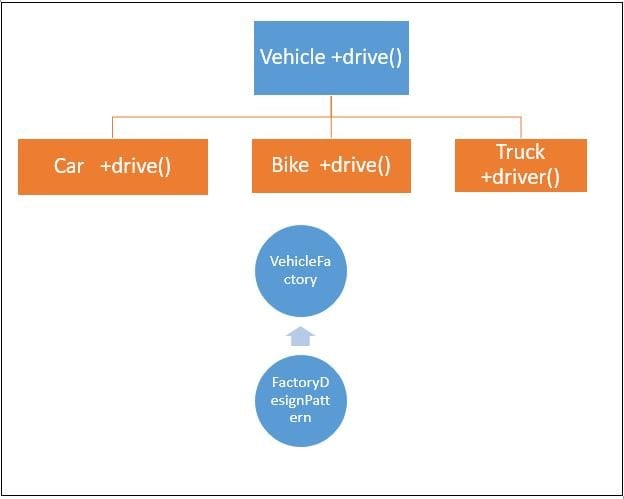
In the last chapter, we discussed about the overview, concepts, application and categorization of various Design Patterns which obey standardized coding practice and help novice developers learn about the software design very swiftly within no time. In this chapter, we are going to discuss about Factory Pattern, which is one of the most commonly used design patterns in Java/J2EE. It falls under the category of creational design pattern as this pattern help us provide a common and very simple way to create objects and hide the actual creation logic.
In Factory design pattern, an object is created without exposing the actual creation logic to the client and with the help of a common interface reference can be made to a newly created object.
Implementation of Factory design pattern
To understand the design pattern, we are going to create a Vehicle interface and concrete classes (i.e., Car, Bike and Truck classes) which implement the Vehicle interface. A factory class VehicleFactory is defined in the next step.
The FactoryDesignPattern class will use the VehicleFactory class to get a Vehicle object. It will pass information (i.e. CAR / BIKE / TRUCK) to VehicleFactory to get the type of object it needs.

Step 1: – Creation of an interface i.e. Vehicle.java
package com.eduonix.design.pattern;
/**
*
* @author Aparajita
*
*/
public interface Vehicle {
void drive();
}
Step 2: – Creation of the three concrete classes (i.e., Car, Bike and Truck classes) which implements the same interface i.e. Vehicle.java
Car.java
package com.eduonix.design.pattern;
/**
*
* @author Aparajita
*
*/
public class Car implements Vehicle{
@Override
public void drive() {
System.out.println ("Inside Car::drive () method.");
}
}
Bike.java
package com.eduonix.design.pattern;
/**
*
* @author Aparajita
*
*/
public class Bike implements Vehicle{
@Override
public void drive() {
System.out.println ("Inside Bike::drive () method.");
}
}
Truck.java
package com.eduonix.design.pattern;
/**
*
* @author Aparajita
*
*/
public class Truck implements Vehicle{
@Override
public void drive() {
System.out.println ("Inside Truck::drive () method.");
}
}
Step 3: – Creation of a Factory in order to generate object of concrete class based on the given information.
VehicleFactory.java
package com.eduonix.design.pattern;
/**
*
* @author Aparajita
*
*/
public class VehicleFactory {
// use getDrive method to get object of type drive.
public Vehicle getDrive (String driveType) {
if (driveType == null) {
return null;
}
if (driveType.equalsIgnoreCase("CAR")) {
return new Car();
} else if (driveType.equalsIgnoreCase("BIKE")) {
return new Bike();
} else if (driveType.equalsIgnoreCase("TRUCK")) {
return new Truck();
}
return null;
}
}
Step 4: – Creation of FactoryDesignPattern class in order to use the Factory to get an object of the concrete class by simply passing an information such as type.
FactoryDesignPattern.java
package com.eduonix.design.pattern;
/**
*
* @author Aparajita
*
*/
public class FactoryDesignPattern {
public static void main(String args[]) {
System.out.println ("Demonstrating Factory Design Pattern!");
VehicleFactory vehicleFactory = new VehicleFactory();
// get an object of Car and call its drive method.
Vehicle vehical1 = vehicleFactory.getDrive ("CAR");
// call draw method of Circle
vehical1.drive();
// get an object of Bike and call its drive method.
Vehicle vehical2 = vehicleFactory.getDrive ("BIKE");
// call draw method of Rectangle
vehical2.drive();
// get an object of Truck and call its drive method.
Vehicle vehical3 = vehicleFactory.getDrive ("TRUCK");
// call draw method of circle
vehical3.drive();
}
}
Step 5: – When we execute FactoryDesignPattern class as a Java application, then will observe the following desired output which demonstrate the Factory design pattern.
Demonstrating Factory Design Pattern! Inside Car::drive () method. Inside Bike::drive () method. Inside Truck::drive () method.
Source code for the design pattern in java
Conclusion: –
In this chapter, we discussed the factory design pattern in detail along with a suitable example. In that example, we have demonstrated the step by step creation of Interface, concrete classes, factory class and Factory design implementer class.


